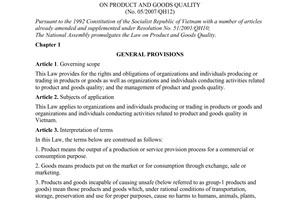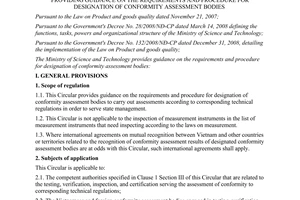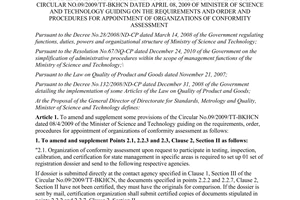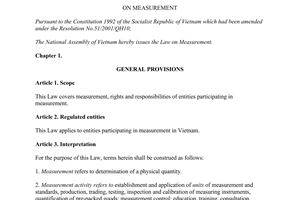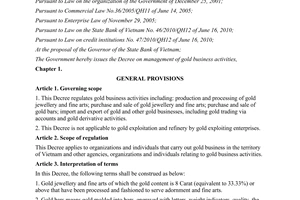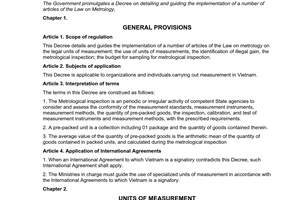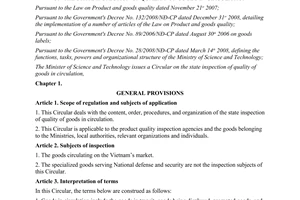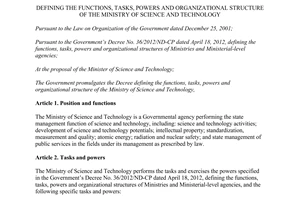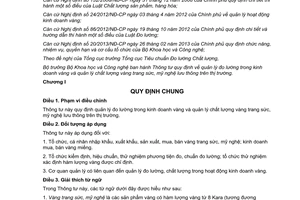Nội dung toàn văn Circular No. 22/2013/TT-BKHCN quality management of gold jewelry on the market
|
MINISTRY OF SCIENCE
AND TECHNOLOGY |
SOCIALIST REPUBLIC
OF VIETNAM |
|
No. 22/2013/TT-BKHCN |
Hanoi, September 26, 2013 |
CIRCULAR
ON MANAGEMENT OF MEASUREMENT IN GOLD TRADING AND QUALITY MANAGEMENT OF GOLD JEWELRY ON THE MARKET
Pursuant to the Law on Product and goods quality dated November 21, 2007;
Pursuant to the Law on Electricity dated November 11, 2011;
Pursuant to the Government's Decree No. 89/2006/ND-CP dated August 30, 2006 on goods labels;
Pursuant to the Government's Decree No. 132/2008/ND-CP dated December 31, 2008, detailing the implementation of a number of articles of the Law on Product and goods quality;
Pursuant to the Government's Decree No. 24/2012/ND-CP dated April 03, 2012 on gold trading management;
Pursuant to the Government's Decree No. 86/2012/ND-CP dated October 19, 2012 elaborating and providing guidance on the implementation of the Law on Measurement;
Pursuant to the Government's Decree No. 20/2013/ND-CP dated February 26 2013 defining the functions, tasks, entitlements and organizational structure of the Ministry of Science and Technology;
At the request of the Director of the Directorate for Standards, Metrology, and Quality,
The Minister of Science and Technology promulgates a Circular on management of measurement in gold trading and quality management of gold jewelry on the market,
Chapter I
GENERAL PROVISIONS
Article 1. Governing scope
This Circular specifies the management of management in gold trading and quality management of gold jewelry on the market.
Article 2. Subjects of application
This Circular is applicable to:
1. The organizations and individuals that import, export, manufacture, trade in gold jewelry, or trade in gold bullions.
2. The organizations that inspect, calibrate measuring instruments and measurement standards; the organizations appointed to analyze gold content (hereinafter referred to as appointed analyzing organizations).
3. The management agencies related to measurement in gold trading.
Article 3. Interpretation of terms
In this Circular, the terms below are construed as follows:
1. Gold jewelry is gold products with gold content of 8 karat (33.3%) or more, crafted into jewelry or for decoration.
2. Gold content is the percentage (%) of gold in the piece of jewelry.
3. Karat (K) is the parts of gold (by weight) out of 24 parts of the gold alloy.
4. Purity is the number of parts of gold (by weight) out of 1000 parts of the gold alloy.
The conversion of units of measurement of gold is specified in Table 3 in this Circular.
5. Pure gold is the type of gold with purity over 999 parts per thousand (ppt) .
6. Gold alloys are alloys composed of gold and one or some other elements.
7. Gold trading includes import, export, manufacture, trading in gold jewelry, trading in gold bullions.
Chapter II
MEASUREMENT IN GOLD TRADING
Article 4. For import, export, manufacture, trading in gold jewelry, trading in gold bullions
The organizations and individuals that import, export, manufacture, trade in gold jewelry, or trade in gold bullions must comply with the regulations below:
1. The scale used for weighing gold weight must satisfy the requirements below:
a) The measuring range and accuracy are suitable for the amount of gold being weighed. The capacity of the scale must be suitable for its readability (e) in Table 1.
Table 1
|
Capacity |
Readability (e) |
|
Up to 500 g |
≤ 1 mg |
|
> 500 g to 3 kg |
≤ 10 mg |
|
> 3 kg to 10 kg |
≤ 100 mg |
|
> 10 kg |
≤ 1 g |
b) The scale must be inspected by a recognized or appointed inspecting organization; the certificate of inspection (seal, stamp, certificate) must be unexpired.
2. The weights used for determining the weight of gold in trading, or for periodically checking the scale as prescribed in Clause 1 of this Article must satisfy the requirements below:
a) The nominal weight and accuracy are conformable with the scale;
b) The weights are inspected by a recognized or appointed inspecting organization; the certificate of inspection must be unexpired.
3. The weight of gold traded or tested must not be smaller than the weight announced. Variance of gold weight must not exceed the limits in Table 2.
Table 2
|
No. (i) |
Gold weight (m) |
Tolerance (S) |
|
Expressed as gram (g) |
Express as milligram (mg) |
|
|
1 |
30 |
12.5 |
|
2 |
50 |
17 |
|
3 |
100 |
30 |
|
4 |
200 |
56 |
|
5 |
300 |
81 |
|
6 |
500 |
131 |
|
Expressed as kilogram (kg) |
|
|
|
7 |
1 |
240 |
|
8 |
1.5 |
350 |
|
9 |
2 |
425 |
|
10 |
3 |
575 |
|
11 |
5 |
900 |
|
12 |
6 |
1 050 |
|
|
According to measurement results |
|
|
13 |
> 6 |
0.0175 % |
The tolerance on the gold weight not mentioned in Table 2 is determined as follows:
a) For m < 30="" g,="" the="" tolerance="" (s)="" is="" calculated="" as="" follows="" and="" rounded="" up="" to="" the="" readability="" (e)="" of="" the="">
= ![]() (12.530 ∗ )
(12.530 ∗ )
Example 1:
A golden ring weighs 7.5 g using a scale with e = 1 mg. The tolerance (S) is:
![]()
b) For 30 g <>m < 6000="" g,="" the="" tolerance="">(S) is calculated as follows and rounded up to the readability (e) of the scale:
![]()
Where:
S: upper tolerance;
m: gold weight;
![]() : two consecutive
values of gold weight with ordinal numbers i and i + 1 in Table 2,
provided
: two consecutive
values of gold weight with ordinal numbers i and i + 1 in Table 2,
provided ![]() ;
;
![]() : tolerance in Table
2 corresponding to
: tolerance in Table
2 corresponding to ![]() ;
;
Example 2:
A golden bracelet weighs 86 g (m = 86 g) using a scale with e = 1 mg. According to Table 2, 50 g < 86="" g="">< 100="">
Thus:
![]()
Tolerance (S):

c) For m > 6 kg, the tolerance (S) is calculated by multiplying the result by 0.0175%, and rounded up to the readability of the scale.
Example 3:
A gold bar weighs 10 kg using a scale with e = 100 mg. The tolerance (S) is:
S= (10 x 0.0175 %) kg ~ 1.8 g
4. The scale must be check by the user at least once a week. Documents about the periodic check shall be kept at a place convenient for the inspection of competent agencies/persons.
Article 5. Analyzing gold content in gold jewelry
The organization appointed to analyze gold content mentioned in Article 9 of this Circular must comply with the following regulations:
1. The instruments used for analyzing gold contents must:
a) Have a capacity range suitable for the amount of gold being analyzed;
b) Have a tolerance not higher than 1/2 of the tolerance on the result of gold content analysis prescribed in Clause 3 of this Article;
c) Be calibrated once a year by a calibration service provider as prescribed by the Law on Measurement; have an unexpired certificate of calibration.
2. The materials used for periodically inspect and calibrate instruments used for testing gold content must satisfy the requirements below:
a) The gold content is suitable for the capacity of the instrument that needs inspecting and calibrating;
b) The level of unreliability of gold content must not exceed 7/10 of the tolerance on the instrument that need inspecting and calibrating;
c) They are tested or compared by an organization that provide measurement standard testing services, or by a foreign national agency specialized in analyzing titrants, or by a laboratory associated with such agency. The Certificate of analysis must be unexpired.
3. Tolerance on the result of analysis of gold content in gold jewelry:
a) 1% if gold content is 99.9% of higher;
b) 2% if gold content is from 80% to below 99.9%;
c) 3% if gold content is below 80%.
Chapter III
GOLD JEWELRY QUALITY CONTROL
Article 6. Quality requirements of gold jewelry
1. Gold jewelry shall be classified by purity of gold corresponding to the gold content in Table 3.
Table 3
|
Karat (K) |
Purity (‰) Not smaller than |
Gold content (%) Not smaller than |
|
24K |
999 |
99.9 |
|
23K |
958 |
95.8 |
|
22K |
916 |
91.6 |
|
21K |
875 |
87.5 |
|
20K |
833 |
83.3 |
|
19K |
791 |
79.1 |
|
18K |
750 |
75.0 |
|
17K |
708 |
70.8 |
|
16K |
667 |
66.6 |
|
15K |
625 |
62.5 |
|
14K |
585 |
58.3 |
|
13K |
541 |
54.1 |
|
12K |
500 |
50.0 |
|
11K |
458 |
45.8 |
|
10K |
416 |
41.6 |
|
9K |
375 |
37.5 |
|
8K |
333 |
33.3 |
2. When classifying by karat, gold jewelry shall be sorted into the lower class preceding its actual karat value according to Table 3 (e.g. 21.5-karat gold jewelry shall be classified as 21K) When classifying by purity or gold content, the true value shall be announced (e.g. if gold content in a piece of gold jewelry is 78.0%, the announced purity shall be 78% or 780).
3. The welding materials made of gold alloys must have at least an equal purity to the announced class of the piece of gold jewelry. The use of welding materials that are not gold alloys or glue must be announced, including the amount of adhesives, if it causes the product weight to exceed the tolerance in Table 2 Article 4 of this Circular.
4. The piece of gold jewelry that has more than one primary part (except for welding materials and parts such as pins, screws, etc.) made of gold alloys with various classes in Table 3 shall be sorted into the lowest class.
5. Other base metal alloys than gold alloys may be used to enhance the mechanical strength of the piece of gold jewelry if gold alloys are not capable.
The base metal parts must be so processed that they are distinguishable from the parts made of gold alloys. The use of other base metals than gold alloys must be stated in the announcement of composition.
6. If the piece of gold jewelry is coated with other metal or non-metal materials than gold for decorative purpose, the coating must be thin enough to not affect the weight of the product. If the weight of the coating exceeds the limit in Table 2, it must be stated in the announcement of composition and quality.
7. If filler materials are used in the piece of gold jewelry, it must be specified and the fact that the product is not completely made of gold alloys must be announced.
8. The composition of gold jewelry (including base metal, coating, welding materials, adhesive, etc.) must not contain harmful or unhealthy constituents beyond the permissible limits according to relevant regulations.
9. Gold content is the piece of gold jewelry (or parts that contain gold) must not be lower than the announced gold content. The tolerance on the result of gold content analysis is specified in Clause 3 Article 5 of this Circular.
10. Gold jewelry may only be traded on the market after they are labeled and applied standards are announced according to Article 7 of this Circular.
Article 7. Announcement of applied standards and labeling of gold jewelry
1. Applied standards are combinations of compulsory specifications and information prescribed in this Circular, or other necessary information about the products announced by the manufacturer or importer of gold jewelry (based on national standards, regional standards, foreign standards, international standards, or internal standards).
2. The announcement of applied standards must contain the following information:
a) Information about the products, the manufacturer, and the distributor:
- Goods names (e.g. bracelet, necklace, golden ring, etc.);
- Name, address of the manufacturer or the distributor that represent the trademark;
- The brand name and hallmark of the product;
- The number of the Certificate of registration of exclusive right to industrial design, registration of brand name, etc. (if any);
b) Technical specifications:
- Weight of gold or composition of gold alloys in the product, and weight of the items fixed on the piece of gold jewelry (e.g. diamonds, sapphires, rubies, etc.);
- Gold content (e.g. 999 or 99.9% or 24K) of the product (or the alloy that primarily makes up the products if it has more than one constituent);
- Description of the piece of gold jewelry:
+ Design, size;
+ Items fixed thereon (e.g. gemstones);
+ Solid, uniform gold;
+ Other base metal plated or coated with gold; information about the base metal;
+ Welding materials, adhesive, etc. (if they are used according to Article 6 of this Circular);
+ The product has empty cavities or filled with other materials, information about filler materials;
+ Gold products made of multiple constituents and specific information;
+ Method (casting, manual, automatic).
- Commitment not to use substances harmful to human health in gold jewelry in accordance with relevant laws.
c) Marking gold jewelry:
- “G.P” if the product if base metal plated or coated with gold;
- “G.F” if the product has its cavities filled with other materials and is not completely made of gold or gold alloys in the same class of purity;
- “C” if the product is coated with a thin layer of transparent non-metal material;
- “P” if the product is plated with a thin layer of metal or an alloy that does not contain gold;
- If the product is made of another alloys or materials and plated with gold by various methods (coating, sticking, rolling, plating, etc.) with a gold content (pure gold) from 1/40 of the product weight, the ratio of gold content to total weight of the product must be specified and bear the marking G.P or G.F (e.g. 1/40 G.P 24K, 1/20 G.F 18K...).
d) Other information (to clarify or avoid confusion).
3. The standards applied to gold jewelry shall be announced on:
a) The price list of gold jewelry; or
b) The package of gold jewelry; or
c) The label of gold jewelry; or
d) The document packed with the gold jewelry.
4. Labeling gold jewelry:
a) General requirements:
- Gold jewelry shall be labeled in accordance with the Government's Decree No. 89/2006/ND-CP dated August 30, 2006 on goods labeling. The position of labels shall comply with Article 6 of the Decree No. 89/2006/ND-CP;
- Labels of gold jewelry may be directly put on the products by mechanical engraving, laser engraving, embossing or other methods (if the size and structure of the product allows), or on the documents enclosed with the product;
- The class of purity prescribed in Article 6 of this Circular must be noticeably displayed on the products using Arabian numbers that indicate the gold content expressed as parts per thousand (e.g. 999 or 916, etc.) or in Arabian numbers together with the letter K (e.g. 24K or 22K, etc.) corresponding to their class.
If the size of the product does not allow direct display, the gold contain must be announced on its label. If the product is made of two alloys with different gold content and difference may be sensually recognized, the gold content shall be displayed on the part with the smaller gold content;
- For imported gold jewelry, apart from the original label in foreign languages, an additional label showing the information in Point b Clause 4 of this Article and its origin in Vietnamese language must be put on.
b) Label contents:
- The label put on gold jewelry must contain the following information:
Goods names (e.g. bracelet, necklace, golden ring, diamond ring, etc.);
+ Name and marking of the manufacturer (e.g. PAJ, SJC, DOJ, etc.);
+ Gold content as prescribed in Point a Clause 4 of this Article (e.g. 999 or 99.9% or 24K);
The weight of gold and weight of the items fixed on the piece of gold jewelry (e.g. diamonds, sapphires, rubies, etc.);
+ The marking of the piece of gold jewelry according to Point c Clause 2 of this Article.
- Direct labeling on the product (if its size allows):
+ Marking of the product (e.g. PAJ, SJC, DOJ, etc.);
+ Gold content as prescribed in Point a Clause 4 of this Article (e.g. 999 or 99.9% or 24K);
+ The marking of the piece of gold jewelry according to Point c Clause 2 of this Article.
Article 8. Rules for sampling and method for gold content analysis
1. The rules for taking samples serving gold content analysis shall be imposed by the analyzing organization.
2. Rules for taking samples serving the inspection of gold jewelry on the market:
a) Samples shall be taken when the goods quality is questionable or a complaint/lawsuit is filed. The sampling method must be suitable for the purpose, requirements, ensure the objectivity and transparency;
b) The amount of samples taken must be sufficient for testing the indicators required by the testing method in Appendix I to this Circular. If the product consists of multiple detachable parts, a sample must contain every part of the product when it is bought, sold, or exchanged;
c) When taking samples, the inspecting agency shall make a sampling record (form 1a.BBLM in Appendix II to this Circular). The sampling record must be certified by representatives of relevant parties and the witnesses (where necessary).
If the representative of the trader refuses to sign on the sampling record, the inspecting agency shall specify in the record that “the representative refuses to sign on the sampling record”. The sampling record bearing the signatures of the samples and the chief of the inspectorate is still valid.
3. The method for analyzing gold content in gold jewelry is specified in Appendix I to this Circular. Gold jewelry shall be tested by an analyzing organization appointed by the Directorate for Standards, Metrology, and Quality as prescribed in Article 9 of this Circular.
Article 9. Appointment of analyzing organization
1. Requirement for an analyzing organization:
a) Satisfying the requirements in the Circular No. 09/2009/TT-BKHCN dated April 08, 2009 of the Minister of Science and Technology on requirements and procedure for appointing a conformity assessment body, and the Circular No. 11/2011/TT-BKHCN dated June 30, 2011 of the Minister of Science and Technology on amendments to the Circular No. 09/2009/TT-BKHCN;
b) Satisfying the requirements on measurement in Article 5 of this Circular.
2. Procedure for appointing an analyzing organization:
a) The analyzing organization that wishes to analyze gold content shall make 01 application and send it directly or by post to the Directorate for Standards, Metrology, and Quality;
b) An application consists of:
- An application form for appointment to analyze gold content (Form 2.DKCD in Appendix II to this Circular);
- A copy of the Certificate of registration for testing;
- A list of testers that meet the requirements in Clause 1 of this Article (Form 3.DSTNV in Appendix II to this Circular) enclosed with the evidence of their qualifications;
- A list of documents and standards serving the testing (Form 4.DMTL-TC in Appendix II to this Circular) enclosed with the procedure for gold content analysis;
- A list of machinery, equipment and titrants serving the gold content analysis (Form 5.DMTB-CC in Appendix II to this Circular) enclosed with a copy of the certificate of calibration, certificate of reference materials, the result of the test for proficiency (in gold content analysis) and relevant documents (if any);
- A form of test result sheet.
c) Within 15 working days from the day on which the sufficient and valid application is received, the Directorate for Standards, Metrology, and Quality shall examine the application and issue a decision to appoint the applicant to analyze gold content (form 6.QDCD in Appendix II to this Circular) if the application is satisfactory. The decision on appointment shall be valid for up to 03 years.
If the application is not satisfactory and a site inspection is necessary, the Directorate for Standards, Metrology, and Quality shall send experts or an inspectorate to carry out an inspection at the premises of the analyzing organization within 30 working days from the day on which the sufficient application is received. The inspection cost shall be incurred by the analyzing organization.
Based on the application, the site inspection result, and the remedial measures, the Directorate for Standards, Metrology, and Quality shall issue a decision to appoint the applicant to analyze gold content (form 6.QDCD in Appendix II to this Circular) within 10 working days. The decision on appointment shall be valid for up to 03 years.
If the application is rejected, the Directorate for Standards, Metrology, and Quality shall notify the reasons for rejection to the applicant within 15 working days;
d) 03 months before the decision on appointment expires, the analyzing organization may applies for another registration as prescribed in Point a and Point b of this Clause.
Article 10. Suspension and revocation of the decision on appointment of analyzing organization
1. The decision on appointment of analyzing organization shall be suspended when the analyzing organization commits one of the violations below:
a) Failing to comply with the test procedure;
b) Failing to maintain the conditions for gold content analysis prescribed in this Circular.
2. The decision on appointment of analyzing organization shall be revoked in one of the cases:
a) The analyzing organization is dissolved, bankrupt, or commits serious violations of law;
b) The analyzing organization recommits the violations and seriously omits the requirements for gold content analysis;
c) There is evidence that the information provided in the application is not truthful;
d) The analysis result is given without actually performing the analysis of gold content;
dd) A written request for permission to stop providing gold content analysis service is made;
e) The decision is suspended but the analyzing organization fails to rectify the errors by the deadline written in the notification of suspension.
3. The analyzing organization that has the decision on appointment revoked may apply for the appointment after 01 year from the date on which the notification on revocation is issued if all violations are rectified.
Chapter IV
GUIDANCE ON INSPECTION AND PENALTIES FOR VIOLATIONS PERTAINING TO MEASUREMENT AND QUALITY
Article 11. Inspection
1. The organizations and individuals that import, export, sell, buy gold jewelry or gold bars (hereinafter referred to as traders) must enable competent authorities to carry out quality inspections.
2. The quality inspection of gold jewelry during the manufacture process shall comply with the Circular No. state inspection 16/2012/TT-BKHCN dated August 27, 2012 of the Minister of Science and Technology on quality inspection of the products under the management of the Ministry of Science and Technology.
The quality inspection of gold jewelry on the market shall comply with the Circular No. state inspection 26/2012/TT-BKHCN dated December 12, 2012 of the Minister of Science and Technology on quality inspection of goods on the market.
3. The quality inspection of gold jewelry in gold trading must comply with legislation on inspection.
4. The samples must be tested the non-destructive method in Appendix I of this Circular. The testing cost shall be incurred by the inspecting agency.
If the trader does not concur with the test result, they may request the inspecting agency to have the samples of gold jewelry tested again by another analyzing organization. In this case the non-destructive method in Appendix I of this Circular shall be employed. The testing cost shall be incurred by the trader.
If the sample of gold jewelry does not allow the employment of the non-destructive method, both parties shall negotiate an agreement on using the destructive method in Appendix I of this Circular. The testing cost shall be incurred by the trader.
The test result is the basis for the inspecting agency to draw the final conclusion.
The appointed analyzing organization shall return the samples to the inspecting agency after the test is done. The inspecting agency shall return the samples to the trader.
Article 12. Penalties for violations
The organizations and individuals that import, export, sell, buy gold jewelry or gold bars that violate the regulations in this Circular shall incur penalties according to the Law on Product and goods quality and the Law on Measurement. During the inspection, the administrative violations discovered shall be penalized in accordance with the Government's Decrees on penalties for administrative violations pertaining to quality and measurement, or face criminal prosecution.
Chapter V
RESPONSIBILITIES OF GOLD TRADERS, ANALYZING ORGANIZATIONS, AND STATE AGENCIES
Article 13. Responsibilities of gold traders
1. Responsibilities of the organizations and individuals involved in the measurement of traded gold:
a) Comply with the regulations on measurement in this Circular;
b) Comply with the regulations on units of measurement; discharge the duties imposed by legislation on measurement when engage in measurement in the manufacture, import, export, purchase, sale of gold jewelry and gold bars;
c) Take the measures requested by competent authorities in order to inspect the measuring method and results of gold content analysis given to the client;
d) Retain the documents about internal inspection of the scales, weights, and instruments for gold content analysis;
dd) Facilitate the inspection of measurement, comply with the decisions on inspection made by competent authorities.
2. Responsibilities of gold jewelry traders:
a) Comply with the regulations on measurement and quality control in this Circular;
b) Only trade in the gold jewelry that is conformable with the applied standards, bears the markings and gold content;
c) Announce the applied standards and label the products in accordance with this Circular; post the applied standards at the business place in accordance with Article 7 of this Circular for consumers to know and make their choices;
d) Retain the documents about gold jewelry quality, including:
- Results of the gold content analyses under applied standards;
- The applied standards;
- Documents about the labels of gold jewelry according to Article 7 of this Circular (e.g. labels put on products, pictures of products showing the markings, warranty sheet showing the information about the label contents, etc.)
dd) Take responsibility for conformity quality of the gold jewelry sold to consumers with the applied standards, this Circular, and relevant law;
e) Facilitate the inspection of quality and labeling; comply with the decisions on inspection made by competent authorities.
Article 14. Responsibilities of the appointed analyzing organization
1. Exercise the rights and fulfill the obligations mentioned in Article 19 and Article 20 of the Law on Product and goods quality. The violations against this Circular or Article 20 of the Law on Product and goods quality shall incur penalties as prescribed in the Decree on penalties for administrative violations pertaining to standard, measurement, and goods quality, or face criminal prosecution.
2. Send annual reports and irregular reports (on request) on gold content analysis results to the Directorate for Standards, Metrology, and Quality (form 7. BCKQTN in Appendix II to this Circular).
3. Report any change that might affect the analysis gold content to the Directorate for Standards, Metrology, and Quality within 15 days from the occurrence of the change.
Article 15. Responsibilities of the Director of the Directorate for Standards, Metrology, and Quality
1. Consider approving measuring instruments; certify measurement standards; issue certificates of registration, appoint organizations to inspect, calibrate, test measuring instruments and measurement standards. Supervise the assessment, calibration, testing of measuring instruments and measurement standards of appointed organizations.
2. Appoint capable organizations to run analyze gold content in accordance with this Circular. Supervise the operation of appointed analyzing organizations. Suspend or revoke the decision on appointment if the appointed organization violates the regulations in this Circular.
3. Take charge and cooperate with relevant organizations in measurement and quality inspection as prescribed in this Circular and relevant law.
4. Provide guidance on measurement techniques for relevant organizations and individuals in accordance with this Circular.
Article 16. Responsibilities of Services of Science and Technology of central-affiliated cities and provinces
1. Instruct affiliated units to implement this Circular.
2. Consider approving the dissemination plans and inspection plans pertaining to measurement in gold trading and quality of gold jewelry on the market.
3. Instruct specialized units affiliated to the Service of Science and Technology to cooperate with relevant units in inspecting the measurement in gold trading and quality of gold jewelry on the local market in accordance with this Circular and relevant law.
Article 17. Responsibilities of Sub-departments of Standards, Metrology, and Quality of central-affiliated cities and provinces
1. Provide guidance on measurement techniques for relevant organizations and individuals in accordance the plan approved by the Service of Science and Technology.
2. Instruct specialized units affiliated to the Service of Science and Technology to cooperate with relevant units in inspecting the measurement in gold trading and quality of gold jewelry on the local market in accordance with this Circular and relevant law.
3. Send annual reports and irregular reports (on request) to the Service of Science and Technology and the Directorate for Standards, Metrology, and Quality on the measurement in gold trading and quality of gold jewelry on the local market.
Article 18. Responsibilities of Inspectors of Services of Science and Technology
1. Inspect or cooperate with competent authorities in inspecting the measurement in gold trading and quality of gold jewelry on the local market in accordance with this Circular.
2. Send annual reports and irregular reports (on request) to the Service of Science and Technology and the Inspectorate of the Ministry of Science and Technology on the inspection of measurement in gold trading and quality of gold jewelry on the local market.
Chapter VI
IMPLEMENTATION
Article 19. Effect
This Circular takes effect on June 01, 2014.
Article 20. Organizing the implementation
1. When the legislative documents referred to in this Circular are amended or replaced, the new documents shall apply.
When the standards referred to in this Circular are amended or replaced, the new standards shall apply.
2. the Directorate for Standards, Metrology, and Quality shall provide guidance on and organize the implementation of this Circular.
3. The difficulties that arise during the implementation must be reported to the Ministry of Science and Technology for consideration and settlement./.
|
|
PP THE MINISTER |
APPENDIX I
METHOD
FOR ANALYSIS OF GOLD CONTENT IN GOLD JEWELRY
(to the Circular No.
22/2013/TT-BKHCN dated September 26, 2013 of the Minister of Science and
Technology)
1. Gold content analysis
Prepare the samples in accordance with ISO 11596:2008 in combination with one of the following test methods to analyze gold content in the sample of gold jewelry:
a) Non-destructive method:
X-ray fluorescent method for quick determination of gold content in Vietnam’s Standards 7055:2002 - Gold and fold alloys. X-ray fluorescent method for determination of gold content;
b) Destructive method:
- Cupellation method (fire assay) in ISO 11426:1997 - Determination of gold in gold jewelry alloys -- Cupellation method (fire assay);
- ICP - OES method in ISO 15093:2008 - Jewelry -- Determination of precious metals in 999‰ gold, platinum and palladium jewelry alloys -- Difference method using inductively coupled plasma optical emission spectroscopy (ICP-OES), used for the samples with gold content over 99.9%.
2. Preserving and handling samples
a) The samples of gold jewelry that remain after the test is done must be safely preserved. The preservation period shall be specified by the inspecting agency.
b) When the preservation period expires, the preserved samples and the samples that remain after the analysis must be sealed and returned to the sender by the analyzing organization.
The return of such samples must be recorded in writing (Form 8.BBTM in Appendix II to this Circular) certified by representatives of relevant parties. /.
APPENDIX II
FORMS
(to the Circular No. 22/2013/TT-BKHCN dated September 26, 2013 of the Minister
of Science and Technology)
1. Sampling record:
- Form 1a. BBLM
- Form 1b. PNPM
2. Application form for appointment to analyze gold content:
Form 2. DKCD
3. List of testers:
Form 3. DSTNV
4. List of technical documents and standards serving gold content analysis:
Form 4. DMTL-TC
5. List of machinery, equipment and titrants serving gold content analysis:
Form 5. DMTB-CC
6. Decision on appointment:
Form 6. QDCD
7. Reports on gold content analysis results:
Form 7. BCKQTN
8. Record on sample return:
Form 8. BBTM
Form 1a. BBLM
|
NAME OF GOVERNING BODY (if any) NAME OF INSPECTING AGENCY |
SOCIALIST REPUBLIC
OF VIETNAM |
|
No. .................... |
[Location & date] |
SAMPLING RECORD
1. Name, type, marking of gold jewelry: ...............................................................
2. Name of gold jewelry shop: ...............................................................
3. Address & phone number: .................................................................................
4. Sampling method: ..................................................................................
5. Sampling purpose:
□ Inspecting market circulation
□ Other purposes :……….………...….…………
6. Quantity of samples taken: .................................................................................
7. Quantity of seals corresponding to the quantity of samples taken: ....................
8. Gemstones are fixed on samples: □ Yes □ No
(Specify the type of gemstones e.g. diamond, sapphire, ruby, etc, size, weight of gemstones and identifying characteristics .....................................................................................
9. Sample description: (shape, marking, stated quantity, pLU code, pictures)
10. Returned samples are intact: □ Yes □ No.
Specific requirements: ..........................................................................................
11. Retention period: ...........................................................................................
12. Test method: ..................................................................................
Other requirements: ....................................... This record is made into two copies with equal validity. Each party shall keep one copy.
|
Representative of gold jewelry trader (Full name, signature, seal) |
Sample taker (signature, full name)
|
Chief commissioner
(signature, full name)
Witness (full name, ID number, or name of the agency if the event is witness by a representative of the local government, police department, etc.)
Form 1b. PNPM
SAMPLE SEALING NOTE
According to sampling record No. ... dated ...
Sample name: ..................................................................................
Seal number: .............................................................................
Sampling date: ..................................................................................
|
Representative of gold jewelry trader (Full name, signature, seal) |
Sample taker (signature, full name)
|
----------------------------------
Notes: This note must bear the seal of the inspecting agency.
Form 2. DKCD
SOCIALIST REPUBLIC OF
VIETNAM
Independence
- Freedom - Happiness
--------------------------
[Location & date]
APPLICATION FORM
FOR APPOINTMENT TO TEST FOR GOLD CONTENT
To: the Directorate for Standards, Metrology, and Quality
1. Name of analyzing organization: ........................................................................
2. Address: ………………………………………………................
Phone number: …………..... Fax: ………………. E-mail: …………..............
3. Decision on Establishment/Certificate of Business registration/Investment license No. ... Issuer: .................... Date of issue: ......……. in ...................................
4. Enclosed documents:
- .....
- .....
5. After considering the conditions for gold content analysis in the Circular No. 22/2013/TT-BKHCN dated September 26, 2013 of the Minister of Science and Technology, we believe that the requirements for gold content analysis are satisfied (specify the criteria the applicant is capable to analyze).
We would like to be appointed by the Directorate for Standards, Metrology, and Quality to analyze gold content.
We commit to adhere to state regulations on the appointed tasks and take responsibility for the truthfulness of the information above.
|
|
Representative of analyzing organization (Full name, signature, seal) |
Form 3. DSTNV
Name of analyzing organization: .......................................................................
LIST OF TESTERS
|
No. |
Full name |
Qualifications |
Certificate of training in testing |
Work experience |
Type of labor contract |
Notes |
|
1 |
|
|
|
|
|
|
|
2 |
|
|
|
|
|
|
|
3 |
|
|
|
|
|
|
|
4 |
|
|
|
|
|
|
|
5 |
|
|
|
|
|
|
|
.... |
|
|
|
|
|
|
|
.... |
|
|
|
|
|
|
........ We, [Name of the analyzing organization], here by declare that the information furnished above is true to the best of our knowledge.
|
|
[Location & date] Representative of analyzing organization (Full name, signature, seal) |
Form 4. DMTL-TC
Name of analyzing organization: .......................................................................
LIST OF DOCUMENTS AND STANDARDS
SERVING THE TEST ON GOLD JEWELRY
|
No. |
Name of documents |
Number |
Effective date |
Issuer |
Notes |
|
1 |
|
|
|
|
|
|
2 |
|
|
|
|
|
|
3 |
|
|
|
|
|
|
4 |
|
|
|
|
|
|
5 |
|
|
|
|
|
|
.... |
|
|
|
|
|
|
.... |
|
|
|
|
|
|
|
[Location & date] Representative of analyzing organization (Full name, signature, seal) |
Form 5. DMTB-CC
Name of analyzing organization: .......................................................................
LIST OF MACHINERY, EQUIPMENT AND TITRANTS
SERVING THE TEST ON GOLD JEWELRY
1. List of machinery and equipment
|
No. |
Name, number, category, specification of machinery or equipment |
Number |
Year of manufacture |
Country of origin |
Commencement year and condition of equipment |
Notes |
|
1 |
|
|
|
|
|
|
|
2 |
|
|
|
|
|
|
|
3 |
|
|
|
|
|
|
|
4 |
|
|
|
|
|
|
|
.... |
|
|
|
|
|
|
2. List of titrants
|
No. |
Name, symbol |
Year of manufacture |
Manufacture and country of origin |
Specification |
Titrant certificate and validity period |
|
1 |
|
|
|
|
|
|
2 |
|
|
|
|
|
|
3 |
|
|
|
|
|
|
... |
|
|
|
|
|
.......... We, [Name of the analyzing organization], here by declare that the information furnished above is true to the best of our knowledge.
|
|
[Location & date] Representative of analyzing organization (Full name, signature, seal) |
Form 6. QDCD
|
MINISTRY OF SCIENCE
AND TECHNOLOGY |
SOCIALIST REPUBLIC
OF VIETNAM |
|
No. /QD-TDC |
[Location & date] |
DECISION
To appoint an organization to analyze gold content
DIRECTOR OF THE DIRECTORATE FOR STANDARDS, METROLOGY, AND QUALITY,
Pursuant to the Prime Minister’s Decision No. ... dated ... defining the functions, tasks, powers and organizational structure of the Directorate for Standards, Metrology, and Quality;
Pursuant to the Government's Decree No. 24/2012/ND-CP dated April 03, 2012 on gold trading management;
Pursuant to the Circular No. 22/2013/TT-BKHCN dated September 26, 2013 of the Minister of Science and Technology on management of measurement in gold trading and quality management of circulating gold jewelry;
At the request of ... [name of a unit appointed by the Directorate for Standards, Metrology, and Quality to examine applications),
DECIDES:
Article 1. To appoint [name of the analyzing organization] under the management of [name of the governing body, if any] located at [address] to analyze gold content.
Article 2. This Decision is valid for 03 years from the day on which it is signed.
Article 3. [Name of the analyzing organization] is responsible for analyzing gold content on request to serve state management, comply with the regulations and instructions of competent authorities, and is totally responsible for the test result they give.
Article 4. [Name of the analyzing organization and relevant organizations are responsible for the implementation of this Decision./.
|
|
DIRECTOR
|
Form 7. BCKQTN
|
NAME OF GOVERNING
BODY (if any) |
SOCIALIST REPUBLIC
OF VIETNAM |
|
No. .........../BC-......... |
[Location & date] |
REPORT ON GOLD CONTENT ANALYSIS
From [date] to [date]
To: The Directorate for Standards, Metrology, and Quality
1. Name of the analyzing organization: ..................................................................
2. Address: .......................................................................................
3. Phone number: ..........................Fax: ..............................E-mail: ................................
4. Operation:
[Name of the unemployment benefit] reports the analyses of gold content that have been performed from [date] to [date] as follows:
a) Total quantity of gold jewelry tested:
a) Names and categories of gold jewelry tested:
c) Quantity of unsatisfactory samples: ............ Causes: .........................
5. Suggestions (if any).
…………..( Name of the analyzing organization) reports to the Directorate for Standards, Metrology, and Quality for information./.
|
|
Representative of analyzing organization (Full name, signature, seal) |
Form 8. BBTM
|
NAME OF GOVERNING
BODY (if any) |
SOCIALIST REPUBLIC
OF VIETNAM |
|
No. .................... |
[Location & date] |
RECORD ON SAMPLE RETURN
1. Name, type, marking of gold jewelry: ...............................................................
2. Sender: ..................................................................................
Address & phone number: ......................................................................................
3. Analyzing organization: ..................................................................................
Address & phone number: ......................................................................................
4. Quantity of samples sent: ..................................................................................
5. Quantity of seals corresponding to the quantity of samples sent: ......................
6. Gemstones are fixed on samples: □ Yes □ No
(Specify the type of gemstones e.g. diamond, sapphire, ruby, etc, size, weight of gemstones and identifying characteristics ..............................................................................................................
After checking, both parties certify that [name of the analyzing organization] has returned all of the samples after the expiration of the retention period and the samples that remain after the test to [name of the sender].
This record is made into two copies with equal validity. Each party shall keep one copy.
|
Representative of the sender (Full name, signature, seal) |
Representative of analyzing organization (Full name, signature, seal) |

